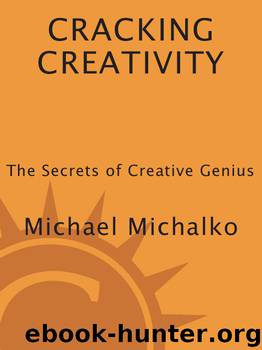Cracking Creativity by Michael Michalko

Author:Michael Michalko [Michalko, Michael]
Language: eng
Format: epub
ISBN: 978-0-307-79036-1
Publisher: Ten Speed Press
Published: 2011-03-16T04:00:00+00:00
Idea Bank
Max Planck, the creator of quantum physics, said new ideas are not generated by deduction, but by a creative imagination that enables one to make unusual associations. Make it a practice to collect and store interesting items like a packrat and use the items to stimulate your imagination. Keep a container (coffee can, shoe box, desk drawer, file folder, etc.) of interesting advertisements, quotes, articles, designs, ideas, questions, cartoons, pictures, doodles, poems, interesting words, and other intriguing items that might trigger additional ideas by association.
When you are working on a challenge, shake up the container and pull an item, at random, to see what connections, links, and intriguing associations you can discover between the item and your subject. Suppose you wanted to improve your business organization and you drew a picture about DNA. What is the connection between DNA, a nucleic acid that carries genetic information in the cell, and a business organization? One might, for example, write out the values and goals of the business as a DNA organizational code that is so tightly compressed that it acts like a mathematical formula. It will lock in the organization to prescribed values and rules of action. Employees will know what the code is and what the rules are.
The great American author, F. Scott Fitzgerald, once remarked that he achieved his ideas and insights by holding two dissimilar subjects or ideas in his head at the same time. The contradiction caused by the dissimilarities created a tension within him. This tension inspired him to overcome the contradiction with a creative idea or insight. This is the principle behind the “Idea Bank.” When you draw two dissimilar subjects (random stimuli) from the bank, you will experience an almost instinctive desire to overcome the contradictions by making connections between the two. These connections trigger new ideas. Other sources of random stimuli are newspapers and magazines.
Download
This site does not store any files on its server. We only index and link to content provided by other sites. Please contact the content providers to delete copyright contents if any and email us, we'll remove relevant links or contents immediately.
Big Magic: Creative Living Beyond Fear by Elizabeth Gilbert(5679)
Paper Towns by Green John(5140)
On Writing A Memoir of the Craft by Stephen King(4893)
The Doodle Revolution by Sunni Brown(4715)
Hyperfocus by Chris Bailey(4087)
Evolve Your Brain by Joe Dispenza(3635)
Unlabel: Selling You Without Selling Out by Marc Ecko(3626)
The Red Files by Lee Winter(3392)
Draw Your Day by Samantha Dion Baker(3321)
The Power of Mindful Learning by Ellen J. Langer(3202)
The Art of Dramatic Writing: Its Basis in the Creative Interpretation of Human Motives by Egri Lajos(3039)
The War Of Art by Steven Pressfield(2911)
Applied Empathy by Michael Ventura(2865)
The 46 Rules of Genius: An Innovator's Guide to Creativity (Voices That Matter) by Marty Neumeier(2820)
How to be More Interesting by Edward De Bono(2768)
Keep Going by Austin Kleon(2730)
Why I Am Not a Feminist by Jessa Crispin(2725)
How to Stop Worrying and Start Living by Dale Carnegie(2691)
You Are Not So Smart by David McRaney(2627)
